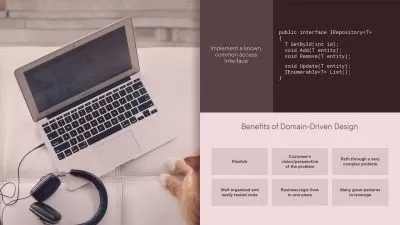Low Level System Design, Design Patterns & SOLID Principles
Prateek Narang
5:44:47
Description
Master Proven Design Techniques and SOLID Principles to Build Robust and Scalable Systems!
What You'll Learn?
- Understand Core Design Patterns: Learn the most widely-used design patterns in Java, including Creational, Structural, and Behavioral patterns
- Apply SOLID Principles: Master the SOLID design principles to write cleaner, more maintainable, and scalable code in your software projects
- Improve Low-Level Design: Gain the ability to design efficient, flexible, and robust object-oriented systems through low-level design practices.
- Build Scalable Applications: Learn how to use design patterns to create scalable and extensible Java applications that can adapt to changing requirements
Who is this for?
What You Need to Know?
More details
DescriptionAre you looking to take your Java programming skills to the next level and master the art of designing scalable, maintainable, and efficient software systems? In this course, Low Level System Design, Design Patterns &Â SOLIDÂ Principles, Prateek Narang, an experienced Software Engineer and Instructor and having worked with companies like Google, Scaler, Coding Minutes etc will guide you through the world of object-oriented design patterns, essential for building robust applications in real-world scenarios.
What You’ll Learn:
Understand the fundamental design patterns used in software engineering and how to apply them effectively in Java.
Explore creational, structural, and behavioral patterns, and their practical use cases.
Write cleaner, more efficient code by leveraging well-established design principles.
Learn how to improve low-level design for building scalable and maintainable applications.
Solve complex design problems with ease using proven design techniques.
Benefits of Doing a Design Patterns Course
Improved Software Design Skills:
Learn how to build flexible, maintainable, and scalable software systems by applying proven design solutions.
Design Patterns are tried-and-tested solutions that help you handle recurring problems in software design.
Enhances Problem-Solving:
Acquire a deeper understanding of common software design challenges and how to solve them using structured approaches.
Patterns provide frameworks for thinking about structural, creational, and behavioral issues in software.
Better Code Readability and Maintenance:
Patterns lead to code that is more understandable and self-explanatory.
By following widely known design patterns, your codebase becomes easier for other developers to read and maintain.
Code Reusability:
Design patterns encourage reusability, which reduces redundancy and makes your codebase more efficient and concise.
Patterns like Factory, Prototype, and Singleton encourage the creation of reusable objects and solutions.
Align with Industry Best Practices:
Design patterns are a fundamental part of object-oriented design and are widely adopted by the industry. Mastering them shows you’re following industry standards.
In interviews and workplace challenges, design patterns often serve as best practices when architecting solutions.
Better Team Collaboration:
Design patterns provide a shared vocabulary for discussing design problems and solutions with other developers.
This common language improves collaboration within teams and makes communication more effective.
Preparation for System Design Interviews:
Many technical interviews for mid-to-senior roles focus on system design questions where knowledge of design patterns is essential.
Mastering the foundational concepts of design patterns is crucial for successfully handling these interviews and presenting scalable, optimized solutions.
Handle Complex Systems:
Gain the ability to break down complex systems into smaller, manageable pieces using patterns like Composite, Facade, and Bridge.
Structural patterns allow you to design systems that are easier to extend and maintain.
Build Scalable and Extensible Architectures:
By using design patterns, you can create systems that can scale with increasing complexity and adapt to changing requirements.
Patterns like Decorator and Strategy support adding functionality or swapping algorithms without modifying existing code.
Improved Decision-Making:
By understanding the pros and cons of each design pattern, you'll be better equipped to make decisions about which approach suits a specific situation.
It enables you to evaluate different design options and pick the most optimal solution.
Framework and Library Understanding:
Modern frameworks and libraries heavily rely on design patterns (e.g., Singleton in Spring Framework, Factory in GUI toolkits).
A strong grasp of design patterns helps you better understand how these frameworks work under the hood.
Career Growth and Opportunities:
Mastery of design patterns is often expected for senior-level roles (e.g., architect, tech lead), improving your chances for career advancement.
It increases your confidence to tackle complex design problems and lead teams in making architectural decisions.
Design patterns are the foundation of good software design. They help you solve recurring problems and improve the structure and quality of your code. This course offers hands-on examples and real-world scenarios to help you understand and implement these patterns effectively.
Whether you’re preparing for technical interviews or aiming to write better software, this course will give you the practical skills and confidence you need to level up your design capabilities.
Who this course is for:
- Aspiring Software Developers: Individuals who are new to programming or transitioning to Java and want to build a solid foundation in software design principles.
- Junior to Mid-Level Software Engineers: Developers with some experience in Java who wish to deepen their understanding of design patterns and improve their ability to create maintainable and scalable software.
- Computer Science Students: University students or self-learners seeking to supplement their academic knowledge with practical skills in low-level design and object-oriented programming.
Are you looking to take your Java programming skills to the next level and master the art of designing scalable, maintainable, and efficient software systems? In this course, Low Level System Design, Design Patterns &Â SOLIDÂ Principles, Prateek Narang, an experienced Software Engineer and Instructor and having worked with companies like Google, Scaler, Coding Minutes etc will guide you through the world of object-oriented design patterns, essential for building robust applications in real-world scenarios.
What You’ll Learn:
Understand the fundamental design patterns used in software engineering and how to apply them effectively in Java.
Explore creational, structural, and behavioral patterns, and their practical use cases.
Write cleaner, more efficient code by leveraging well-established design principles.
Learn how to improve low-level design for building scalable and maintainable applications.
Solve complex design problems with ease using proven design techniques.
Benefits of Doing a Design Patterns Course
Improved Software Design Skills:
Learn how to build flexible, maintainable, and scalable software systems by applying proven design solutions.
Design Patterns are tried-and-tested solutions that help you handle recurring problems in software design.
Enhances Problem-Solving:
Acquire a deeper understanding of common software design challenges and how to solve them using structured approaches.
Patterns provide frameworks for thinking about structural, creational, and behavioral issues in software.
Better Code Readability and Maintenance:
Patterns lead to code that is more understandable and self-explanatory.
By following widely known design patterns, your codebase becomes easier for other developers to read and maintain.
Code Reusability:
Design patterns encourage reusability, which reduces redundancy and makes your codebase more efficient and concise.
Patterns like Factory, Prototype, and Singleton encourage the creation of reusable objects and solutions.
Align with Industry Best Practices:
Design patterns are a fundamental part of object-oriented design and are widely adopted by the industry. Mastering them shows you’re following industry standards.
In interviews and workplace challenges, design patterns often serve as best practices when architecting solutions.
Better Team Collaboration:
Design patterns provide a shared vocabulary for discussing design problems and solutions with other developers.
This common language improves collaboration within teams and makes communication more effective.
Preparation for System Design Interviews:
Many technical interviews for mid-to-senior roles focus on system design questions where knowledge of design patterns is essential.
Mastering the foundational concepts of design patterns is crucial for successfully handling these interviews and presenting scalable, optimized solutions.
Handle Complex Systems:
Gain the ability to break down complex systems into smaller, manageable pieces using patterns like Composite, Facade, and Bridge.
Structural patterns allow you to design systems that are easier to extend and maintain.
Build Scalable and Extensible Architectures:
By using design patterns, you can create systems that can scale with increasing complexity and adapt to changing requirements.
Patterns like Decorator and Strategy support adding functionality or swapping algorithms without modifying existing code.
Improved Decision-Making:
By understanding the pros and cons of each design pattern, you'll be better equipped to make decisions about which approach suits a specific situation.
It enables you to evaluate different design options and pick the most optimal solution.
Framework and Library Understanding:
Modern frameworks and libraries heavily rely on design patterns (e.g., Singleton in Spring Framework, Factory in GUI toolkits).
A strong grasp of design patterns helps you better understand how these frameworks work under the hood.
Career Growth and Opportunities:
Mastery of design patterns is often expected for senior-level roles (e.g., architect, tech lead), improving your chances for career advancement.
It increases your confidence to tackle complex design problems and lead teams in making architectural decisions.
Design patterns are the foundation of good software design. They help you solve recurring problems and improve the structure and quality of your code. This course offers hands-on examples and real-world scenarios to help you understand and implement these patterns effectively.
Whether you’re preparing for technical interviews or aiming to write better software, this course will give you the practical skills and confidence you need to level up your design capabilities.
Who this course is for:
- Aspiring Software Developers: Individuals who are new to programming or transitioning to Java and want to build a solid foundation in software design principles.
- Junior to Mid-Level Software Engineers: Developers with some experience in Java who wish to deepen their understanding of design patterns and improve their ability to create maintainable and scalable software.
- Computer Science Students: University students or self-learners seeking to supplement their academic knowledge with practical skills in low-level design and object-oriented programming.
User Reviews
Rating
Prateek Narang
Instructor's Courses
Udemy
View courses Udemy- language english
- Training sessions 47
- duration 5:44:47
- Release Date 2025/02/25






![Python Design Patterns: Complete Guide [2023 Edition]](https://traininghub.ir/image/course_pic/24241-x225.webp)



